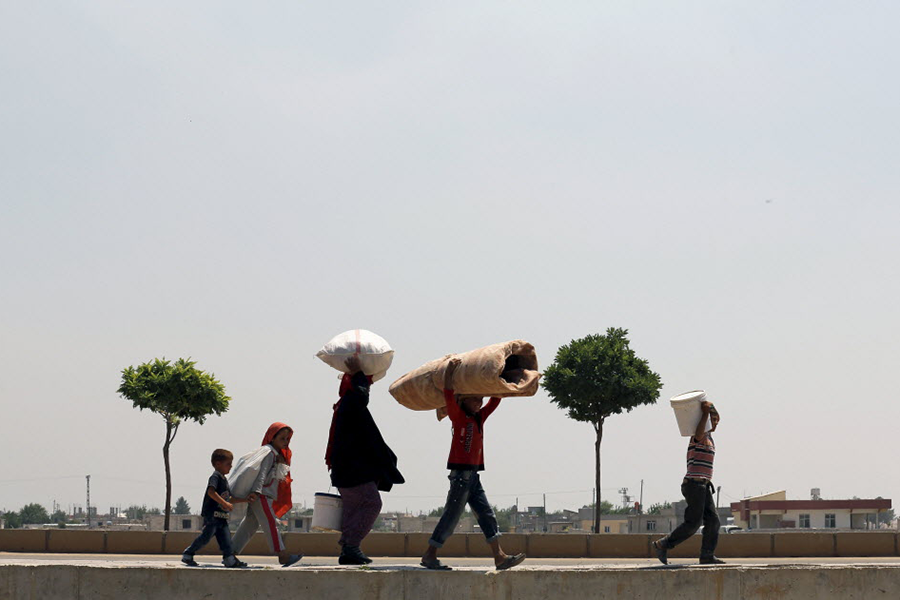Refugees return to site of Syrian battle, uncertain which side to fear more
Loading...
| Akcakale, Turkey
Hundreds of refugees who had fled into Turkey in recent days crossed back into Syria Wednesday, hoping the dust had settled after a Kurdish-led coalition snatched the strategic border town of Tel Abyad from Islamic State militants.
Skeptical that IS fighters had been driven out for good, some women undertook the return journey with their faces covered by a black niqab, an Islamic garment in line with the draconian dress code imposed by the jihadists for the past two years.
Their tentative return represents just the latest small chapter in the humanitarian disaster created by the more than four-year Syrian war that has displaced millions and left more than 300,000 dead by some estimates.
Tel Abyad had become an important transit town for foreign fighters headed to the capital of the IS “caliphate” in Raqqa City. Its loss to the US-backed Kurdish fighers and their allies stripped the expansionist IS of a vital supply line, marking its worst battlefront defeat in Syria.
In Akcakale, which forms the Turkish half of a divided city with Tel Abyad, a modest sprawl of mid-rise homes comes to a halt at the crude border fence and railway track separating Turkey from Syria.
“The Islamic State is gone, gone, gone,” Umm Aboud calls out with outright glee but no malice as the cautiously dressed women make their way back to the Syrian side.
“They are just scared that there are still IS elements inside, or that IS will return in full force,” explains the gregarious Tel Abyad native, who arrived here Monday.
Umm Aboud continues to wear a headscarf but was more than happy to discard the niqab, even when sleeping amid strangers in a tiny park in Akcakale.
Tel Abyad, in Syria’s northern Al-Raqqa Governorate, has changed hands several times in the course of Syria’s brutal conflict, with salafist jihadists making an entrance in 2012.
For some, IS meant stability
Prior to IS, in reverse chronological order, Tel Abyad was dominated by Al Qaeda affiliate Jabhat al-Nusra, by rebels linked to the Free Syrian Army (FSA), and by the regime of President Bashar al-Assad. The last time Kurdish fighters under the banner of the YPG/YPJ – Syrian Kurdish factions comprising men and women – clashed with Islamist fighters in Tel Abyad was the summer of 2013.
Yassin Habbash, a bricklayer traveling back to Syria with his sister and nephew, says he can’t cope with another night sleeping under the stars. He is full of apprehension about his return, but not because he fears a lingering IS presence.
“Without a doubt, the best phase was under IS. They brought safety and stopped corruption,” he says. “Now we have the Kurds and the FSA. We all know the FSA are thieves. The Kurds are the question mark.”
His appreciation for that relative stability is not universally shared.
“IS didn’t steal like the Free Syrian Army before them, but the pressure was just unbearable,” quips Umm Aboud, hiding from the scorching sun under a tree. “We knew Allah and the prophet Mohammed well before they rolled into town and forced our sons to study Islamic Law.
Airstrikes also feared
“All the time I had to be black from head to toe,” she says. “If a woman was caught wearing a gold bracelet or ring, they demanded she pay Zakat,” she adds, referring to the Islamic tax or alms-giving, a key tenet of the Muslim faith.
Those making the journey back consulted friends and relatives who remained in Tel Abyad before deciding to return.
“The situation is still not stable, but we’ve been told by those who stayed behind to guard their homes that we can come back,” says Umm Yasser, still traumatized by her journey into Turkey – a chaotic stampede of thousands of refugees fleeing clashes and the airstrikes of a US-led coalition that softened the path for advancing Kurds and their allies.
“There is no room for us here and we can’t afford to pay rent,” explains Zahra, waiting to cross with her green-eyed girls. “We had grown accustomed to the Islamic Sate, we had adapted. Now with the Kurds, I have no clue how things will evolve, but we are not scared of them. The main problem is the airstrikes, they really frighten our children.”
Shamse al-Baggara, an elderly woman who saw fit to share her tribe’s name instead of the family name, decided to wait and see. Flanked by four sons of fighting age, she smokes incessantly, stopping only to sip water from sunbaked, dusty bottles.
Fleeing one battle for another
“When there are no planes left in the sky, then it will be safe for us to go back,” she says. “The bombing we experienced was so intense I nearly had a heart attack. We left with the clothes on our back and left the pots burning on the stove.”
“When the Kurds came into Tel Abyad, they came in strong,” interjects her son Omar. “We thought it was impossible for IS to be defeated.… I suspect it is not over.”
Further into the city, dozens of families have hunkered down for the long haul, building tents out of heavy wool blankets and shredded scarves that come undone at the slightest gust of wind.
All of them arrived from Tel Abyad, but some of them are natives of Deir Ezzor, a province further east, where IS militants are trying to crush the last regime-held pockets.
“We fled one battle and stumbled onto the next,” says Fadil Alabdullah, holding himself up with a crutch. “It’s been four years of endless back and forth. Now we are here, just in time for Ramadan.”







